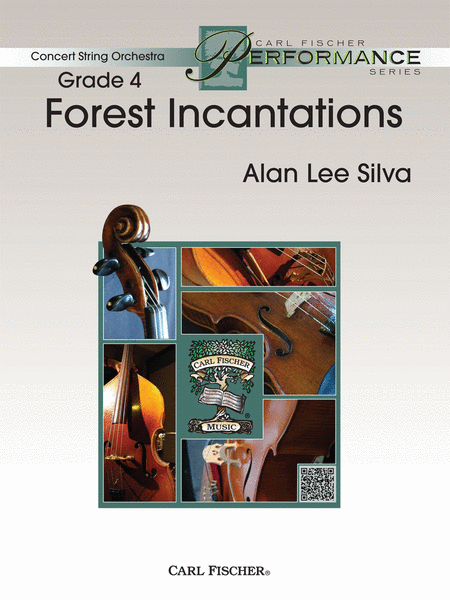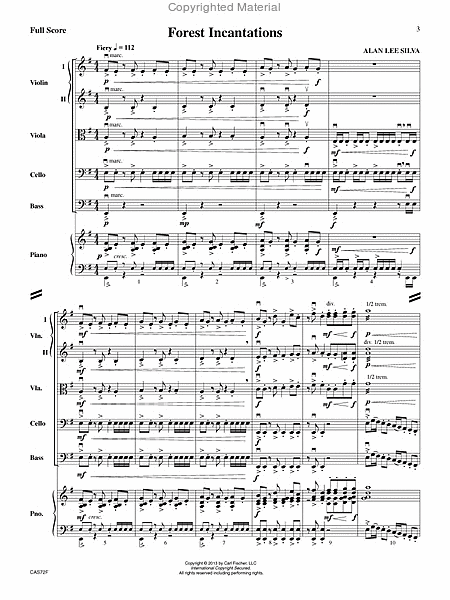Forest Incantations
-
Ships in 1 to 2 weeks
Details
Description
SKU: CF.CAS72
Composed by Alan Lee Silva. SWS FS. Carl Fischer Concert String Orchestra Series. Set of Score and Parts. With Standard notation. 16+16+1+10+4+10+6+10+16 pages. Duration 4 minutes, 23 seconds. Carl Fischer Music #CAS72. Published by Carl Fischer Music (CF.CAS72).ISBN 9780825891526. UPC: 798408091521. 9 x 12 inches. Key: E minor.
From the opening ensemble marcato accents and the driving sixteenth-note unisons in the low strings, Forest Incantations is a compelling musical statement from the very beginning. This active, “edge of your seat” composition provides all sections of the string orchestra with unique and satisfying musical challenges. This is one of Alan Silva's best to date.
From the opening ensemble marcato accents and the driving sixteenth-note unisons in the low strings, Forest Incantations creates a compelling musical statement from the outset. This active “edge-of-your- seat” composition provides all sections of the string orchestra with unique and satisfying musical challenges. Written in a modified “Fast/Slow/Fast” structure, the piece begins with the lively main theme in E minor, departs to new motifs in mm. 56-96, and ends with variations on the main theme.The ensemble plays with urgency and energy from the first measure, charging through the introduction to set the stage for the main theme played by the first violins. This theme in mm. 11-26 (and each time it recurs) is played vigorously but not too heavy, as it needs to be executed precisely and effortlessly. The supporting marcato pulses in the rest of the group are strong and provide a solid rhythmic beat.The momentum slows briefly starting in m. 26 as the rhythms shift from sixteenths to eighths and from eighths to quarters to half notes. The piece disappears to nothing in m. 31, and then is jolted back by the aggressive low strings' pickups into m. 32. The piece lightens a bit at m. 40 with the first violins playing the main tune, and the cellos playing counterlines. In mm. 44-47, the violas and cellos become the stars, accompanied by counterlines in the violins. In mm. 48-55, the melodic rhythm slows to quarters and eighths as the ensemble plays full out on the syncopated accents; this variation of the main theme is showcased in parallel harmony in the high strings and contrary motion in the low strings.Measure 56 gets quieter, and the tone shifts as the ensemble plays warm, sustained chords. A lyrical, violin solo is featured in m. 59 and continues over light, steady staccatos in the rest of the group at m. 64. Accenting beats 1 and 2 is integral to solidify the feel of the accompaniment. The violin solo and staccato accompaniment ends in m. 72, and the ensemble builds to the next section with an expressive legato swell.The "Grand" section at m. 73-76 is a short introduction to a new theme. The new theme (m. 77-92), played molto espressivo by 1st violins, soars above the rest of the group who plays tight harmonies and syncopated rhythms underneath. The mid and low strings can dig in to the double stops in m. 83-84. The tempo slows slightly at m. 93 and the group plays staggered, sustained tremolos to bridge back to the main theme at m. 97.M. 97 to the end is played with the same spirit and fire as the beginning of the piece. The Ó sustained chords in m. 118-120 briefly vary the momentum as the ensemble starts softly and builds to a strong climax as the voicings ascend. The silent bar in m. 121 is a short pause before the exciting final exclamation in m. 122-125.
About Carl Fischer Concert String Orchestra Series
This series of pieces (Grade 3 and higher) is designed for advancing ensembles. The pieces in this series are characterized by:
- Expanded use of rhythms, ranges and keys but technical demands are still carefully considered
- More comprehensive bowing techniques
- Viola T.C. included
- Careful selection of keys and degree of difficulty for advancing musicians


 Share
Share